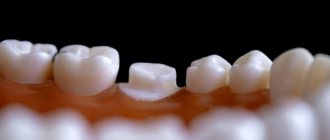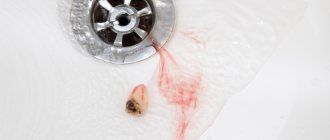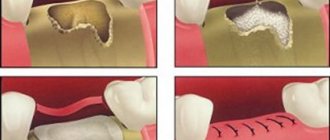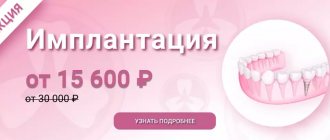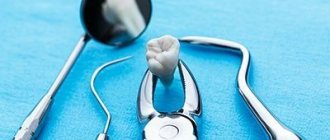Causes of dental injuries
Damage to baby teeth can be caused by any strong force applied to the jaw. For example, if a child was running and accidentally fell with his cheek on some object (chair, curb, step), this may well lead to a bruise or fracture of a tooth. Acute injuries also occur from blows to the face when children fight or play sports like boxing and karate.
Based on the nature of the acquisition, the reasons are divided into household, sports and travel. They are sudden and very painful. There are also chronic injuries that occur due to long-term bad habits. Biting nails, felt-tip pens, ballpoint pens, threads while sewing, or cutlery thins the enamel. Thin, fragile enamel and caries of baby teeth become the main factors of toothache in a child.
Symptoms of a tooth bruise
Immediately after an injury, an appointment with pediatric dentistry is required. Often parents bring their children after a week or a week and a half. This makes examination and treatment of lesions difficult. In the first hours after damage to the masticatory organ:
- Children feel pain.
- Pain increases when biting on a pathological unit.
- The gums swell, redden, and become dense.
- If, as a result of a bruise, a vascular bundle ruptures, blood appears, and pulpal hemorrhage may develop.
- The baby's condition worsens, he becomes restless and whiny.
- The temperature may rise. The child loses his appetite.
Only a doctor can help in such a situation. If a child’s baby tooth darkens after an impact, the blood vessels and pulp tissues could be damaged. In most cases, such processes are reversible. You should take your child to the doctor if there are signs of a bruise. Without treatment, the structure of the abnormal units will suffer, which will negatively impact dental health. The symptoms of severe damage are easy to recognize. In addition to painful sensations, pinkish enamel is clearly visible due to rupture of blood vessels. Brown spots appear after trauma to the periodontal tissues that hold the unit.
In dentistry, the following types are distinguished:
- Bruised tooth. It can be considered the mildest type of injury, which is provoked by blows, attempts to bite through a hard object or “taste” it, which is especially typical for children 1-3 years old.
- Tooth dislocation. Such an injury means that the tooth has moved from its usual place. Typically, this type of injury requires significant force, so it does not occur as often as bruises. There are cases of complete dislocation, when the entire tooth falls out of the socket. Modern pediatric dentistry can save even a lost tooth if there are favorable conditions for this, and parents brought their child in immediately after receiving an injury.
- Tooth fracture. Fractures are immediately visible - these are visible chippings of a corner, piece or most of a baby tooth. Most children break their front teeth; the most popular causes of such damage include fights.
- Fracture of the root or crown of a tooth. They are considered rarer species, because in normal everyday life and sports conditions it is extremely difficult to get such a deep fracture. Regardless of whether the child has acquired a simple tooth bruise or suffered a fracture, in any case it must be shown to a specialist so as not to endanger the health of the young body.
Possible consequences
Moms and dads must remember that the rudiments of the molars suffer from injuries to temporary rudiments. In such permanent teeth, enamel develops poorly and hypoplasia develops. The germ may even die. Therefore, treatment of baby teeth in children should be carried out on time. If the pulp area is severely damaged, the tissues will gradually begin to die and become necrotic. Necrosis causes inflammation and discoloration of the crowns in a dark color. It happens quickly. After some time, cysts form on the damaged areas. To establish a diagnosis, doctors refer for an X-ray examination.
If a child's baby tooth has been displaced by an impact, it may become loose for several weeks. Even slight staggering may occur due to damage to the alveolar process. When mammary rudiments are not treated after injury, it causes irreversible consequences. Swelling and redness usually appear in the area where the main impact occurred. The hematoma can be pronounced, and can also be determined only during palpation. When you press it, the baby experiences discomfort and pain. A fracture of the alveolar process is expressed by pain when moving the jaws. If the ligaments are torn, pain is observed on the entire surface of the dental system.
Causes
There are many reasons for a tooth bruise. The most common is a strong direct blow to the jaw. Athletes often receive such injuries; they are almost always the consequences of accidents. It is impossible not to notice it, since after a blow the front tooth hurts, and the pain is usually sharp.
There is another reason - the so-called chronic jaw injury. The peculiarity of such injuries is that they are insignificant in their impact, but a person is constantly exposed to them. Examples include some human habits: biting nails, holding a pen or pencil in the mouth, cracking nuts, etc. Under the influence of such seemingly insignificant factors, the enamel becomes thinner and microchips form on it. The result of these innocent habits is tooth loss.
Injury can also occur during dental procedures performed by an inexperienced dentist or using old equipment. Any violation of the treatment or removal technique can lead to damage to healthy tissue. That is why our clinic employs experienced, highly qualified specialists. We are responsible for the health of our patients.
Children learn about the world around them through various sensations: visual, auditory, gustatory, tactile. However, the instinct of self-preservation is not yet sufficiently developed in little fidgets, so they often commit actions, the consequence of which, for example, can be injury to baby and permanent teeth in children, i.e. deformation, violation of the anatomical integrity of the tooth and adjacent tissues.
What are the types of injuries and their characteristic symptoms?
Injury
A bruise is understood as the impact of brute force from the outside on a tooth, in which its integrity is not broken. Immediately after such damage and some time later, the baby may complain of pain when eating or during hygiene procedures. In some situations, the damaged unit may become mobile.
Dislocation
A dislocation is an injury to the ligamentous apparatus, connective (periodontal) tissue, as a result of which the coronal part or root changes its location or is displaced. There are several options for the development of events:
- when the dislocation is incomplete: the tooth is in the socket, but its crown part deviates, its position relative to other teeth changes. In this situation, the periodontal connective tissues suffer little or not at all. The baby experiences pain while eating and complains that an incorrectly positioned tooth is bothering him. Also, sometimes the lip and gums swell, and there is slight bleeding from the area of injury,
- when the dislocation is complete: the contact of the tooth with the socket is broken, i.e. connective tissue is torn. The damaged unit can either fall out completely or be held in the socket only by the gums. In the first case, a blood clot may appear in the hole; in the second, the tooth becomes extremely mobile. The damaged area hurts, sometimes it may bleed, there is swelling of the soft tissues,
- when the dislocation is impacted: this situation is considered one of the most common in primary occlusion. When damaged, the tooth is deeply immersed (hammered) into the socket (for example, due to a powerful blow) with penetration into the jaw tissue. As for the tooth itself, it is firmly held in the oral cavity, remaining immobile. However, relative to its “neighbors,” it changes its position and is positioned incorrectly (it tilts or rotates along its axis). Upon examination, it may seem that it has become shorter than other units of the dentition, and it may also completely “hide” in the gum. This option is very dangerous, because with such an injury all tissues are deeply damaged, and when the upper incisors and canines are injured, sometimes there is a risk of damaging even the nasal and maxillary sinuses. The damaged area hurts, the lip and gums in the damaged area are swollen, and the mucous membrane may bleed.
If the injury is severe, tooth dislocation may occur.
Fracture of a tooth crown or root
Dislocations occur most often in temporary and permanent dentition. Less common are root fractures. Injuries can complement each other, for example, a root fracture can be combined with a crown fracture.
Even if the damage does not seem serious, and the child does not express complaints, you need to contact the dentist as soon as possible. Only a specialist can objectively assess the overall picture and decide what to do next. Timely consultation with a doctor will help avoid unnecessary complications.
A tooth fracture implies serious injury to it due to brute force, leading to disruption of the natural structure of the crown or root. The crown can break (chip off) at the enamel level, in the dentin area, or entirely. A minor chip in the enamel does not always bother young patients and their parents, while a chip in the dentin area or a completely chipped, destroyed crown is a serious visual defect. In addition, this situation can also threaten the pulp; traumatic pulpitis often occurs against this background. Also, the sharp edges of the injured unit scratch the tongue, lip, cheek, and interfere with the complete chewing of food. Naturally, in this case, the baby may experience a painful reaction to temperature stimuli and mechanical influences.
Root fracture in childhood is not a common occurrence. The roots of the incisors in the permanent dentition are most vulnerable. A fracture of the root of a baby tooth in a child is observed in exceptional cases. This is explained by the anatomical features of the temporary units and their alveolar process. There are oblique, longitudinal, fragmentation, and combined root fractures. The child experiences pain when biting and chewing food and complains of a loose tooth.
How to solve a problem
Different types of injuries require different approaches to treatment. In all situations, the first stage remains unchanged - visiting the dentist. The doctor will ask about the cause of the injury, complaints, conduct the necessary diagnostics and, depending on the nature of the injury, prescribe treatment:
- in case of bruise: the most important thing is to provide the injured unit with rest, excluding it from the process of chewing food. The nature of the diet will need to be changed by temporarily removing solid foods rich in hard fibers from the diet. Additionally, medications with anti-inflammatory effects may be prescribed. If injury or inflammation of the pulp occurs as a result of the bruise, it will be removed and the canal will be carefully sealed,
- in case of incomplete dislocation with displacement: first of all, the tooth is returned to its correct position. Then it will be fixed with the help of special dental splints, which will not allow it to move again. During the rehabilitation period, it will also be important to follow a gentle diet,
- in case of complete dislocation: the tooth can be removed from the socket, the necessary preparatory procedures can be carried out, and then replanted again (replantation), fixed for a while with splints. In such a situation, it is important to consult a doctor as early as possible, otherwise the chance of successful replantation decreases in proportion to the increase in the time during which you ignore the problem,
- for impacted dislocation: in a child under 2 years of age, the doctor chooses a waiting tactic, because the damaged tooth can recover and continue to grow normally. If this does not happen, most often it is necessary to remove it and think about subsequent prosthetics,
- in case of a crown fracture: if we are talking about a minor chip, then the problem can be solved with the help of restoration - applying a composite material or filling. In case of significant damage, it is more advisable to install a stump inlay or crown, build up a tooth on a pin,
- when the roots of the mammary unit are fractured: it is often simply removed. The same will be done for vertical and comminuted fractures in any bite. If the roots of permanent teeth are fractured, further treatment will depend on the condition of the pulp. Further, restoration will take place through prosthetics.
It should also be remembered that if, as a result of the removal of even the very first, baby tooth, it is very important to promptly take care of the issues of its prosthetics. There are special soft children's dentures that will allow you to preserve the aesthetics and functionality of the dentition for some time - until the primary bite is changed to a permanent one or until the jaw systems are fully formed, when it will be possible to consider the option of higher-quality prosthetics, for example, using dental implantation.
Types of anterior tooth injuries
Most often, it is the front teeth that are injured. There are several common types of injuries.
- Dislocation
Tooth luxation is diagnosed when it is damaged and displaced with trauma to periodontal tissue. It is considered the most common injury to the front teeth in children, since baby teeth are much less resistant to such damage than permanent teeth in adults. Symptoms of luxation are displacement of the tooth from the dentition, periodontal inflammation, bleeding, pathological tooth mobility and severe pain. If the dislocation is incomplete, the doctor can set the tooth back in place; also, with minor damage, the tooth can recover on its own. Complete dislocation requires the tooth to be removed or replaced in its place.
To place the tooth in its proper place, the doctor uses an anesthetic injection. After repositioning, the dentist performs fixation using splinting. The immobility of an injured tooth is ensured by ligatures, mouth guards, staples and other structures that perform the functions of a splint. It is very difficult to fix baby teeth that have insufficiently formed roots. Therefore, in children under two or three years of age, a tooth damaged by dislocation is usually removed.
- Injury
A bruise is a closed injury to tooth tissue. It is characterized by pain during mechanical stress, including chewing, and post-traumatic tissue swelling. Treatment of a bruise consists of grinding the edge of the antagonist tooth and breaking the bite using a special mouthguard or plate. The injured tooth should be kept at rest; solid food should be excluded from the diet for several weeks. If the bruise is accompanied by pulp death, long-term endodontic treatment is necessary.
- Tooth fracture
When a tooth is damaged with a change in the integrity of hard tissues, it is called a fracture. Fractures of the crowns of anterior teeth in children are quite common. A fracture is accompanied by a chipped tooth, pain and bleeding. Treatment for a fracture will depend on the extent of the damage. In case of injury to a baby tooth, the fracture line is fixed with cement and the tooth is left until it is replaced with a permanent dentition. If the tooth is permanent and can be saved, the missing tooth fragment is restored using modern composite materials. However, this presents a certain difficulty - if the roots have not yet formed, you must first protect the pulp and provide normal conditions for root development, and only then deal with the elimination of the aesthetic defect.
IF A CHILD HAS KNOCKED OUT A PERMANENT TOOTH
- The tooth must be found, lifted from the ground, rinsed under cool running water for 10 seconds, holding it by the crown - do not rub or touch the root.
- Insert into place as soon as possible. Don’t be embarrassed that if it protrudes a little, the dentist will correct it as needed. Bite on a handkerchief for better fixation of the tooth.
- If a child or parent is afraid to put the tooth in its place themselves, place the tooth in cow's milk, saline (BUT NOT WATER!!!!) (they also recommend placing the tooth in the mouth of an older child, but how realistic is this - it seems to me unrealistic) and very quickly go to the dentist for a replantation procedure. The child needs to hold the tooth in its natural position with a finger (if there is no fixation by biting, use a handkerchief), and the father should try to drive quickly and carefully, without jerking or braking.
Why are children's teeth so fragile?
Milk teeth do not have a dense structure, like newly erupted permanent teeth. They have not yet had time to ossify to the state of “adult” teeth due to thin enamel and dentin.
Most often, childhood tooth trauma occurs at the ages of 2-4 and 8-10 years. During these years, children lack a sense of fear and danger, and active movement and restlessness contribute to the emergence of dangerous situations.
If your child rides a bicycle, scooter, rollerblades or plays active sports, take care of special protection in the form of a helmet and mouth guard. This will save his teeth and your nerves.
IF A CHILD KNOWS OUT A MILK TOOTH
- Due to the small age of the child, additional technical difficulties immediately arise, therefore, the knocked out tooth, if it has fallen out, should be placed immediately in cow’s milk.
- You need to get to the dentist within 30 minutes.
- There is a possibility that the dentist will refuse to replant a baby tooth, citing the patient’s young age and a change of teeth in the near future, that is, the inappropriateness of the procedure. But baby teeth are also subject to replantation, remember this. If you're lucky, the dentist will turn out to be sane and believes in miracles, and the tooth will be a vigorous, lively person; the child will implant the tooth. Need to try.
The dentist will do additional fixation, prescribe physical procedures, the tooth will take root - that’s elementary.
What to do if your child has a tooth injury
An injury to a child's front tooth requires immediate attention to a dentist. The sooner you go to the doctor, the sooner your baby will receive adequate treatment. Speed of circulation is very important when it comes to preserving dental pulp. To do this, you need to see a doctor no later than two hours after the injury.
When visiting a French dental clinic, our doctors will provide first aid to the child, assess the degree and type of injury and advise you on further actions. Experienced European dentists use all their knowledge and experience to preserve a damaged tooth, restore its health and aesthetic appeal, and also provide acceptable conditions for the development of its root and the formation of a correct bite.

